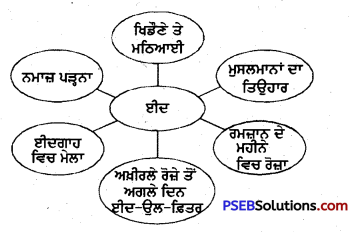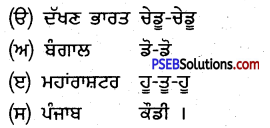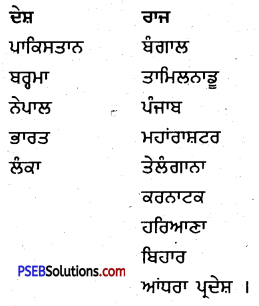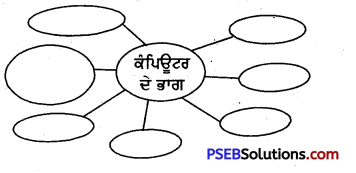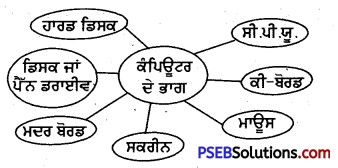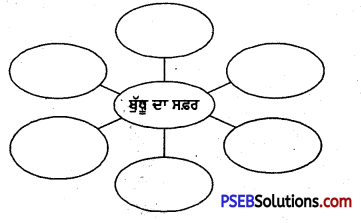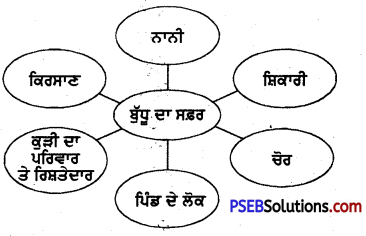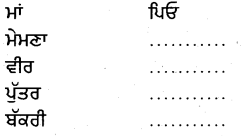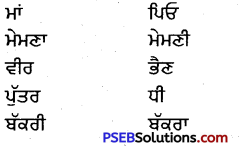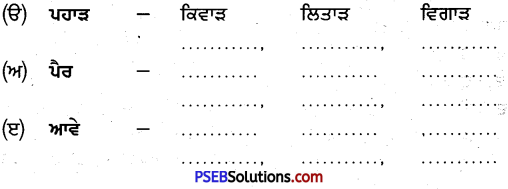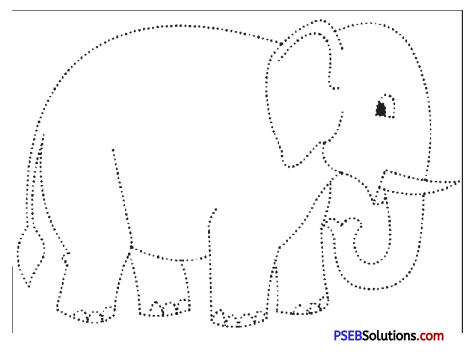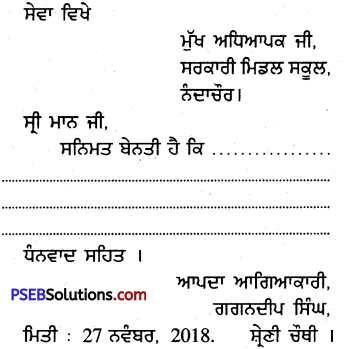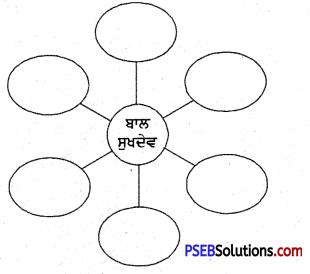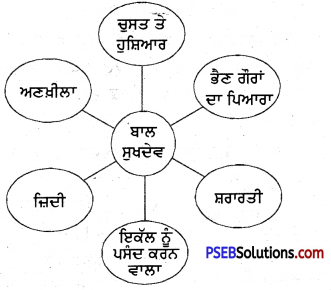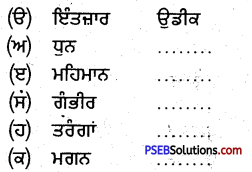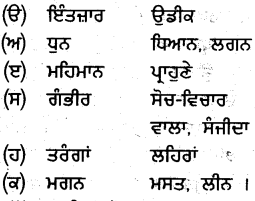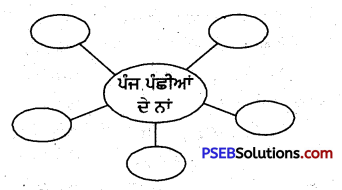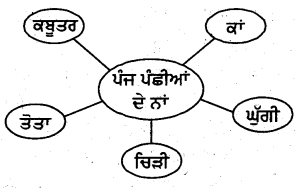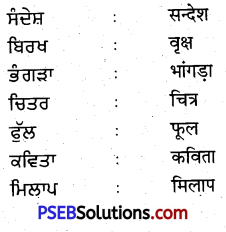Punjab State Board PSEB 4th Class Punjabi Book Solutions Chapter 10 ਈਦ Textbook Exercise Questions and Answers.
PSEB Solutions for Class 4 Punjabi Chapter 10 ਈਦ
ਪਾਠ-ਅਭਿਆਸ ਪ੍ਰਸ਼ਨ-ਉੱਤਰ
ਪ੍ਰਸ਼ਨ 1.
ਈਦ ਕਦੋਂ ਮਨਾਈ ਜਾਂਦੀ ਹੈ ?
ਉੱਤਰ:
ਈਦ ਰਮਜ਼ਾਨ ਦੇ ਮਹੀਨੇ ਵਿਚ ਰੋਜ਼ੇ ਰੱਖਣ ਤੋਂ ਮਗਰੋਂ ਅਖ਼ੀਰਲੇ ਰੋਜ਼ੇ ਤੋਂ ਅਗਲੇ ਦਿਨ ਮਨਾਈ ਜਾਂਦੀ ਹੈ । ਇਸ ਨੂੰ ਈਦ-ਉਲ-ਫ਼ਿਤਰ ਆਖਦੇ ਹਨ ।
ਪ੍ਰਸ਼ਨ 2.
ਈਦਗਾਹ ਪਹੁੰਚ ਕੇ ਸਭ ਨੇ ਕੀ ਕੀਤਾ ?
ਉੱਤਰ:
ਈਦਗਾਹ ਪਹੁੰਚ ਕੇ ਸਭ ਨੇ ਕਤਾਰਾਂ ਵਿਚ ਖੜੇ ਹੋ ਕੇ ਨਮਾਜ਼ ਪੜੀ । ਨਮਾਜ਼ ਪੜ੍ਹ ਕੇ ਹੱਥ ਉਠਾ ਕੇ ਖ਼ੁਦਾ ਤੋਂ ਦੁਆ ਮੰਗੀ । ਇਸ ਤੋਂ ਮਗਰੋਂ ਸਾਰੇ ਇਕ ਦੂਜੇ ਦੇ ਗਲ ਨਾਲ ਲੱਗ ਕੇ ਮਿਲੇ । ਸਭ ਨੇ ਇਕ ਦੂਜੇ ਨੂੰ ਈਦ ਦੀ ਮੁਬਾਰਕਬਾਦ ਦਿੱਤੀ ।
ਪ੍ਰਸ਼ਨ 3.
ਮੇਲੇ ਵਿਚ ਕੀ ਕੁੱਝ ਸੀ ?
ਉੱਤਰ:
ਮੇਲੇ ਵਿਚ ਮਠਿਆਈਆਂ ਤੇ ਖਿਡੌਣਿਆਂ ਦੀਆਂ ਦੁਕਾਨਾਂ ਸਜੀਆਂ ਹੋਈਆਂ ਸਨ । ਮੇਲੇ ਵਿਚ . ਝੂਲੇ ਵੀ ਲੱਗੇ ਹੋਏ ਸਨ । ਬੱਚੇ ਝੂਟੇ ਲੈ ਰਹੇ ਸਨ ।
![]()
ਪ੍ਰਸ਼ਨ 4.
ਸੁਹੇਲ ਨੇ ਮੇਲੇ ਵਿੱਚੋਂ ਕੀ ਖ਼ਰੀਦਿਆ ?
ਉੱਤਰ:
ਸੁਹੇਲ ਨੇ ਮੇਲੇ ਵਿੱਚੋਂ ਖਿਡੌਣਾ ਜਹਾਜ਼ ਖ਼ਰੀਦਿਆ । ਉਸ ਨੇ ਆਪਣੀ ਭੈਣ ਲਈ ਨੱਚਣ ਵਾਲਾ ਇਕ ਰਿੱਛ ਖ਼ਰੀਦਿਆ ।
ਪ੍ਰਸ਼ਨ 5.
ਅੰਮੀ ਨੇ ਸੁਹੇਲ ਦੇ ਦੋਸਤਾਂ ਨੂੰ ਕੀ ਖੁਆਇਆ ?
ਉੱਤਰ:
ਅੰਮੀ ਨੇ ਸੁਹੇਲ ਦੇ ਦੋਸਤਾਂ ਨੂੰ ਸੇਵੀਆਂ ਤੇ ਮਠਿਆਈ ਖਵਾਈ ।
ਪ੍ਰਸ਼ਨ 6.
ਬੈਕਟਾਂ ਵਿੱਚੋਂ ਠੀਕ ਸ਼ਬਦ ਚੁਣ ਕੇ ਖ਼ਾਲੀ ਥਾਂਵਾਂ ਭਰੋ-
(ਈਦਗਾਹ, ਈਦ, ਰਮਜ਼ਾਨ, ਸੇਵੀਆਂ, ਖੁਦਾ ।)
(ਉ) ……. ਵਿਚ ਤੀਹ ਰੋਜ਼ੇ ਰੱਖੇ ਜਾਂਦੇ ਹਨ।
(ਅ) ਘਰ-ਘਰ …….. ਪਕਾਈਆਂ ਜਾ ਰਹੀਆਂ ਹਨ ।
(ਇ) ਸਭ ਲੋਕ …….. ਪਹੁੰਚ ਗਏ ।
(ਸ) ਨਮਾਜ਼ ਪੜ੍ਹ ਕੇ, ਹੱਥ ਉਠਾ ਕੇ …… ਤੋਂ ਦੁਆ ਮੰਗੀ ।
(ਹ) ਸਭ ਨੇ ਇਕ-ਦੂਜੇ ਨੂੰ …… ਦੀ ਮੁਬਾਰਕਬਾਦ ਦਿੱਤੀ ।
ਉੱਤਰ:
(ੳ) ਰਮਜ਼ਾਨ ਵਿਚ ਤੀਹ ਰੋਜ਼ੇ ਰੱਖੇ ਜਾਂਦੇ ਹਨ ।
(ਅ) ਘਰ-ਘਰ ਸੇਵੀਆਂ ਪਕਾਈਆਂ ਜਾ ਰਹੀਆਂ ਹਨ ।
(ਇ) ਸਭ ਲੋਕ ਈਦਗਾਹ ਪਹੁੰਚ ਗਏ ।
(ਸ) ਨਮਾਜ਼ ਪੜ੍ਹ ਕੇ, ਹੱਥ ਉਠਾ ਕੇ ਖ਼ੁਦਾ ਤੋਂ ਦੁਆ ਮੰਗੀ ।
(ਹ) ਸਭ ਨੇ ਇਕ-ਦੂਜੇ ਨੂੰ ਈਦ ਦੀ ਮੁਬਾਰਕਬਾਦ ਦਿੱਤੀ ।
ਪ੍ਰਸ਼ਨ 7.
ਹੇਠ ਲਿਖਿਆਂ ਬਾਰੇ ਜਾਣਕਾਰੀ ਦਿਓ :
ਈਦ, ਰਮਜ਼ਾਨ, ਰੋਜ਼ਾ …
ਉੱਤਰ:
(ੳ) ਈਦ-ਮੁਸਲਮਾਨਾਂ ਦਾ ਇਕ ਤਿਉਹਾਰ, ਜੋ ਰਮਜ਼ਾਨ ਦੇ ਮਹੀਨੇ ਦੇ ਰੋਜ਼ਿਆਂ ਪਿੱਛੋਂ ਅਗਲੇ ਦਿਨ ਮਨਾਇਆ ਜਾਂਦਾ ਹੈ । ਇਸ ਨੂੰ ਈਦੁਲ ਫ਼ਿਤਰ ਕਹਿੰਦੇ ਹਨ ਦੂਜੀ ਈਦ, ਜਿਸਦਾ ਨਾਂ ਈਦੁਲ ਅਜ਼ਹਾ ਹੈ, ਜਿਸਦਾ ਸੰਬੰਧ ਮੱਕੇ ਦਾ ਹੱਜ ਕਰਨ ਤੇ ਪਸ਼ੂ ਦੀ ਬਲੀ ਦੇਣ ਨਾਲ ਹੈ ।
(ਅ) ਰਮਜ਼ਾਨ-ਹਿਜਰੀ ਸਾਲ ਦੇ ਨੌਵੇਂ ਮਹੀਨੇ ਦਾ ਨਾਂ ਰਮਜ਼ਾਨ ਹੈ । ਇਸ ਵਿਚ ਮੁਸਲਮਾਨ ਰੋਜ਼ੇ ਰੱਖਦੇ ਹਨ ।
(ਈ) ਰੋਜ਼ਾ-ਵਰਤ, ਜੋ ਮੁਸਲਮਾਨ ਧਾਰਮਿਕ ਫ਼ਰਜ਼ ਸਮਝ ਕੇ ਰੱਖਦੇ ਹਨ ।
![]()
ਪ੍ਰਸ਼ਨ 8.
ਪੜੋ, ਸਮਝੋ ਅਤੇ ਲਿਖੋ
(ੳ) ਬੱਚਾ – ਬੱਚੇ
(ਅ) ਝੂਲਾ – ………
(ਇ) ਰੋਜ਼ਾ – ………..
(ਸ) ਕੱਪੜਾ – …….
(ਹ) ਖਿਡੌਣਾ – …….
(ਕ) ਕੁੜਤਾ – ………..
(ਖ) ਮਹੀਨਾ – ……..
(ਗ) ਮੇਲਾ – ……….
(ਘ) ਝੂਟਾ – …….
(ਝ) ਪਜਾਮਾ – ……
(ਚ) ਟੱਪਦਾ – ……..
(ਛ) ਨੱਚਦਾ – …….
ਉੱਤਰ:
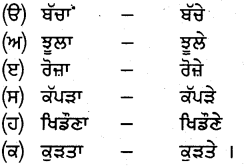
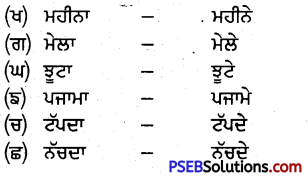
ਪ੍ਰਸ਼ਨ 9.
ਹੇਠ ਲਿਖੇ ਸ਼ਬਦਾਂ ਨੂੰ ਵਾਕਾਂ ਵਿਚ ਵਰਤੋ-
ਤਿਉਹਾਰ, ਖੁਦਾ, ਦੁਆ, ਮੁਬਾਰਕਬਾਦ, ਮਠਿਆਈ, ਮਹੀਨਾ, ਬਜ਼ਾਰ, ਚੂੜੀਆਂ, ਨਮਾਜ਼, ਦੁਕਾਨ ।
ਉੱਤਰ:
- ਤਿਉਹਾਰ (ਖ਼ੁਸ਼ੀ ਦਾ ਦਿਨ)-ਅੱਜ ਈਦ ਦਾ ਤਿਉਹਾਰ ਹੈ ।
- ਖ਼ੁਦਾ (ਬ)-ਖੁਦਾ ਸਭ ਦਾ ਸਾਂਝਾ ਹੈ ।
- ਦੁਆ-ਸਾਰੇ ਲੋਕਾਂ ਨੇ ਨਮਾਜ਼ ਪੜ੍ਹ ਕੇ ਰੱਬ ਕੋਲੋਂ ਦੁਆ ਮੰਗੀ । ..
- ਮੁਬਾਰਕਬਾਦ-ਸਭ ਨੇ ਇਕ-ਦੂਜੇ ਨੂੰ ਈਦ ਦੀ ਮੁਬਾਰਕਬਾਦ ਦਿੱਤੀ ।
- ਮਠਿਆਈ-ਸੁਹੇਲ ਨੇ ਆਪਣੀ ਭੈਣ ਨੂੰ ਮਠਿਆਈ ਦਿੱਤੀ ।
- ਮਹੀਨਾ ਸਾਲ ਦੇ ਸਮੇਂ ਦੇ ਬਾਰਵੇਂ ਹਿੱਸੇ ਦਾ ਨਾਂ, ਜੋ ਆਮ ਕਰਕੇ ਤੀਹ ਜਾਂ ਇਕੱਤੀ ਦਿਨਾਂ ਦਾ ਹੁੰਦਾ ਹੈ)-ਦਸੰਬਰ ਦੇ ਮਹੀਨੇ ਵਿਚ ਠੰਢ ਬਹੁਤ ਹੁੰਦੀ ਹੈ ।
- ਬਜ਼ਾਰ ਖ਼ਰੀਦਣ-ਵੇਚਣ ਲਈ ਨਾਲ-ਨਾਲ ਤੇ ਆਹਮੋ-ਸਾਹਮਣੇ ਬਣੀਆਂ ਦੁਕਾਨਾਂ)-ਬਜ਼ਾਰ ਵਿਚ ਇਕ ਦੁਕਾਨ ਉੱਤੇ ਘੜੀਆਂ ਵਿਕ ਰਹੀਆਂ ਹਨ.
- ਚੂੜੀਆਂ ਵੰਗਾਂ)-ਚੂੜੀਆਂ ਦੀ ਦੁਕਾਨ ਉੱਤੇ ਕੁੜੀਆਂ ਦੀ ਭੀੜ ਲੱਗੀ ਹੋਈ ਸੀ ।
- ਨਮਾਜ਼ (ਮੁਸਲਮਾਨਾਂ ਦੁਆਰਾ ਰੱਬ ਦਾ ਨਾਂ ਲੈਣ ਤੇ ਉਸ ਵਲ ਧਿਆਨ ਲਾਉਣ ਦੀ ਵਿਧੀ)-ਮੁਸਲਮਾਨ ਪੰਜ ਵੇਲੇ ਨਮਾਜ਼ ਪੜ੍ਹਦੇ ਹਨ ।
- ਦੁਕਾਨ (ਹੱਟੀ)-ਬਜ਼ਾਰ ਵਿਚ ਦੁਕਾਨਾਂ ਤਰ੍ਹਾਂਤਰ੍ਹਾਂ ਦੇ ਸਮਾਨ ਨਾਲ ਭੌਰੀਆਂ ਹੋਈਆਂ ਸਨ |
ਪ੍ਰਸ਼ਨ 10.
ਇਸ ਪਾਠ ਵਿਚ ਆਏ ਜੋੜੇ-ਜੋੜੇ ਸ਼ਬਦ ਲਿਖੋ-
ਜਿਵੇਂ ਉਦਾਹਰਨ ਵਿਚ ਦੱਸਿਆ ਗਿਆ ਹੈ :
ਉਦਾਹਰਨ-ਕੁੜਤਾ-ਪਜਾਮਾ ।
ਉੱਤਰ:
ਕੁੜਤਾ-ਪਜਾਮਾ
ਧੂਮ-ਧਾਮ,
ਖਾਂਦੇ-ਪੀਂਦੇ,
ਨਹਾ-ਧੋ,
ਸਲਵਾਰ-ਕਮੀਜ਼,
ਨੱਚਦੇ-ਟੱਪਦੇ,
ਇਕ-ਦੂਜੇ,
ਖ਼ੁਸ਼ੀ-ਖੁਸ਼ੀ ।
ਪ੍ਰਸ਼ਨ 11.
ਈਦਗਾਹ ਦੇ ਬਾਹਰ ਮੇਲਾ ਲੱਗਿਆ ਹੋਇਆ ਹੈ । ਮਠਿਆਈਆਂ ਤੇ ਖਿਡੌਣਿਆਂ ਦੀਆਂ ਦੁਕਾਨਾਂ ਸਜੀਆਂ ਹੋਈਆਂ ਹਨ ਮੇਲੇ ਵਿਚ ਝੂਲੇ ਵੀ ਲੱਗੇ ਹੋਏ ਹਨ । ਬੱਚੇ ਝੂਟੇ ਲੈ ਰਹੇ ਹਨ । ਸੁਹੇਲ ਦੇ ਅੱਬਾ ਨੇ ਮਠਿਆਈ ਖ਼ਰੀਦੀ । ਖਿਡੌਣਿਆਂ ਦੀ ਦੁਕਾਨ ਤੋਂ ਸੁਹੇਲ ਨੇ ਆਪਣੇ ਲਈ ਇਕ ਖਿਡੌਣਾ ਜਹਾਜ਼ ਖ਼ਰੀਦਿਆਂ ਉਸ ਨੇ ਆਪਣੀ ਭੈਣ ਲਈ ਨੱਚਣ ਵਾਲਾ ਇਕ ਰਿੱਛ ਖ਼ਰੀਦਿਆ ।
ਉਪਰੋਕਤ ਪੈਰੇ ਨੂੰ ਪੜ੍ਹ ਕੇ ਹੇਠ ਲਿਖੇ ਪ੍ਰਸ਼ਨਾਂ ਦੇ ਉੱਤਰ ਦਿਓ :-
- ਕਿੱਥੇ ਮੇਲਾ ਲੱਗਾ ਹੋਇਆ ਹੈ ?
- ਕਿਨ੍ਹਾਂ ਚੀਜ਼ਾਂ ਦੀਆਂ ਦੁਕਾਨਾਂ ਸਜੀਆਂ ਹੋਈਆਂ ਹਨ ?
- ਬੱਚੇ ਕਿੱਥੇ ਝੂਟੇ ਲੈ ਰਹੇ ਹਨ ?
- ਮਠਿਆਈ ਕਿਸ ਨੇ ਖ਼ਰੀਦੀ ?
- ਸੁਹੇਲ ਨੇ ਆਪਣੇ ਲਈ ਕੀ ਖ਼ਰੀਦਿਆ ?
- ਸੁਹੇਲ ਨੇ ਭੈਣ ਲਈ ਕੀ ਖ਼ਰੀਦਿਆ ?
ਉੱਤਰ:
- ਈਦਗਾਹ ਦੇ ਬਾਹਰ ।
- ਮਠਿਆਈਆਂ ਤੇ ਖਿਡੌਣਿਆਂ ਦੀਆਂ ।
- ਝੂਲਿਆਂ ਉੱਤੇ ।
- ਸੁਹੇਲ ਦੇ ਅੱਬਾ ਨੇ ।
- ਇਕ ਖਿਡੌਣਾ ਜਹਾਜ਼ ।
- ਨੱਚਣ ਵਾਲਾ ਇਕ ਰਿੱਛ ।
ਪ੍ਰਸ਼ਨ 12.
ਹੇਠ ਲਿਖੇ ਵਾਕਾਂ ਨੂੰ ਸੁੰਦਰ ਲਿਖਾਈ ਕਰ ਕੇ ਲਿਖੋ :
(ਉ) ਰਮਜ਼ਾਨ ਵਿਚ ਤੀਹ ਰੋਜ਼ੇ ਰੱਖੇ ਜਾਂਦੇ ਹਨ ।
(ਅ) ਸੁਹੇਲ ਦੇ ਅੱਬਾ ਨੇ ਮਠਿਆਈ ਖ਼ਰੀਦੀ ।
(ਇ) ਬਜ਼ਾਰਾਂ ਵਿਚ ਬੜੀ ਰੌਣਕ ਹੈ ।
(ਸ) ਘਰ-ਘਰ ਸੇਵੀਆਂ ਪਕਾਈਆਂ ਜਾਂਦੀਆਂ ਹਨ ।
(ਹ) ਉਹ ਗੋਟੇ ਵਾਲੀ ਚੁੰਨੀ ਲੈ ਕੇ ਬਹੁਤ ਖੁਸ਼ ਸੀ ।
ਉੱਤਰ:
(ਨੋਟ-ਵਿਦਿਆਰਥੀ ਆਪ ਹੀ ਲਿਖਣ ) ।
ਪ੍ਰਸ਼ਨ 13.
ਆਪਣੇ ਮਾਤਾ-ਪਿਤਾ ਦੀ ਮੱਦਦ ਨਾਲ ਆਪਣੇ ਘਰ ਵਿਚ ਮਨਾਏ ਜਾਂਦੇ ਤਿਉਹਾਰਾਂ ਦੀ ਸੂਚੀ ਬਣਾਉ ।
ਉੱਤਰ:
- ਲੋਹੜੀ
- ਬਸੰਤ
- ਹੋਲੀ
- ਰੱਖੜੀ
- ਸਰਾਧ
- ਨਰਾਤੇ (ਦੁਰਗਾ ਅਸ਼ਟਮੀ)
- ਸਾਂਝੀ ਮਾਈ
- ਅਹੋਈ ।
- ਕਰਵਾ ਚੌਥ
- ਦੀਵਾਲੀ
- ਗਣੇਸ਼ ਚਤੁਰਥੀ ।
ਪ੍ਰਸ਼ਨ 14.
ਈਦ ਨਾਲ ਸੰਬੰਧਿਤ ਗੱਲਾਂ ਲਿਖੋ ।
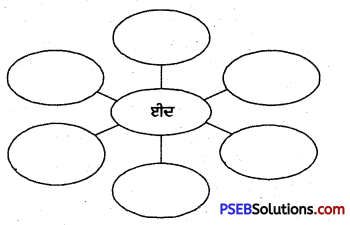
ਉੱਤਰ:
